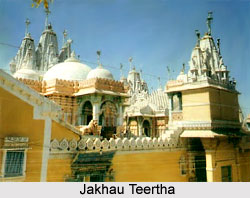 Jakhau teertha located in Gujarat is a Jain pilgrimage centre. It is dedicated to the twenty-fourth tirthankara, Lord Mahavira. It is one of the panchatirthas in Abadasa (Kutch), is situated at a distance of some 108 kms from Bhuj. The temple is in the heart of the town.
Jakhau teertha located in Gujarat is a Jain pilgrimage centre. It is dedicated to the twenty-fourth tirthankara, Lord Mahavira. It is one of the panchatirthas in Abadasa (Kutch), is situated at a distance of some 108 kms from Bhuj. The temple is in the heart of the town.
Temple of Jakhau Teertha
Jakhau Teertha dates back to the ancient time. It houses the idol of Lord Mahavira. The idol is white in complexion and is 84 cm in height. It is seated in a padmasana posture. The temple is also known as Ranatunka Derasara and was constructed under the inspiration of Sheth Jivaraj Ratansi and Sheth Bhimasi Ratansi. In 1905 of the Vikram Samvat Era, Jivaraj Ratansi got the central temple constructed and gave it the name Ratnatunk after the name of his father. Apart from this there are eight other temples located in the same complex. These temples are dedicated to (1) Lord Suvidhinath (2) Lord Adinath, (3) Lord Jiravala Parshvanatha, (4) Lord Chitamani Parshvanatha, (5) Lord Godi Parshvanatha, (6) Lord Gautama Swami, (7) Lord Shantinath and (8) Lord Chandraprabhu Swami. There are many other idols installed in the temple. In total there are 126 idols made of stone, 80 idols that have been carved of metal, 2 of quartz and one of them is made of gold. All the idols look spectacular and stand as a unique example if ancient art. They speak of the artistic skills and talent of the craftsmen. Overall the group of nine temples appears to be one group of temples on the Shatrunjaya Mountain. It looks very appealing even from a distance. After 1905, the temple was religiously renovated in V.S. 2028.
Jakhau Teertha being located on the hill is surrounded by scenic beauty. The atmosphere appears to be mesmerizing and heart-touching. The sight of the rays of the sun falling on the pinnacle-flags on the twenty peaks of the central temple of Lord Mahavira captivates the heart of the pilgrims. The temple organises many annual gatherings and functions. On the fifth day of the bright half of the month of Magha an annual religious festival is celebrated every year. There is provision for dharamshala or rest houses for the pilgrims. These are well equipped with all modern facilities.
Mahuva Teerth is well connected with road and rail. The nearest bus stop is located in Naliya. Busses and taxies are easily available for the kshetra. The nearest railway station is also situated in Naliya at a distance of 12 kms. The closest airport is located at Bhuj.




















